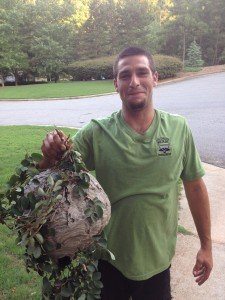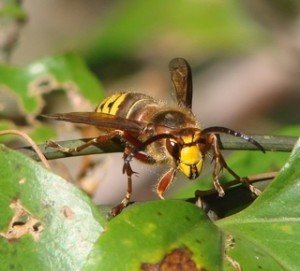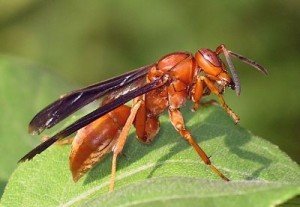
Chemical-FREE Yellowjacket & Hornet Nest Removal

We do more hive removal than anyone we know of in our market – but the important factor is we do it for LESS than most as well! We are not in a race to the bottom because the working conditions during a hive removal are terrible. We are a family owned & operated business and we opted to stay small. This allows us to control the quality of our work & less overhead so our prices are some of the lowest we have found.
Hornets & Wasp type insects nest in the ground or in cavities in your home or building. We’ve seen them in compost bins, voids in walls, old deck furniture, and in chimneys. Some types are extremely aggressive and will protect their nests at all costs. Typically we send two licensed Technicians out in protective suits to perform the work.
Hanging Hornet & Bee Hives
We will, regardless of the height, remove hornet hives (nests) hanging off your eaves, on tree limbs, in bushes… anywhere. We never use any chemicals! We completely remove the hive and take it and as many of the stinging insects possible with us. The fees are based on height, size & complexity.
Give us a call! (678) 850-9520

Underground Yellowjacket Nest Removal
We only use all natural, chemical-free methods to remove ground nests. Our method allows us to capture sometimes hundreds of the stinging insects coming and going. We will spend up to an hour removing the ground nest and trying to get the as many of workers as we can. Next, we remove the hive to be sure the queen, eggs, and as many stray workers are dead or contained and going with us. We always tell people to avoid the area for a day or two after we leave.
Nests Inside a Wall (Cut-Outs)
WARNING!!! EVEN IF YOU DO NOT HIRE US TO REMOVE THE HIVE FROM THE WALL. PLEASE DO NOT LET ANYONE SPRAY THE ENTRANCE OF THE HIVE IF IT GOES INTO A STRUCTURE. More times than not it actually forces the hive deeper into the walls and never kills the Foundress (Queen).
The problem with a nest in a wall void is that the yellowjackets constantly try to expand their nest by chewing. If they are behind sheet rock, it is easy to break through the wall. If you hear nosies in the wall and suspect you have a hive, you could have an emergency in the making. Contact us- we can help!

In house nests are more difficult to get than in ground nests. The reason is the nest is somewhere in a wall void. One method is what we call a “cut-out” to open the wall and remove the yellow jacket nest like we do with honeybees. This method costs more than our non-intrusive method, but it is a complete solution and works perfectly.
You will not find an exterminator who will take the time to get the nest out of your house. Besides, he will probably drill into the wall and FILL it will harmful pesticides. Your home is now contaiminated with poisons. The nest, the eggs, and the remaining insects will die and rot and attract ants, roaches and even rodents.
PLEASE NOTE: To get the nest out of a wall we have to cut into some construction materials (drywall, siding, etc) Although we are as gentle as possible during the process and extremely mindful of repairs. The property owner is responsible for all repairs after we leave.
We service the following areas for stinging insect hive & nest removal: Alpharetta, Cumming, Dahlonega, Dawsonville, Duluth, Johns Creek, Norcross, Sandy Springs, Suwanee, Roswell, Buford, Milton, Marietta, some parts of Woodstock & Atlanta.
INDENTIFYING THE INSECTS

YELLOWJACKET NEST REMOVAL
Very common, majority of our calls for stinging insect nest removal are for Yellowjackets.
Description: (1/2” long) are medium sized wasps marked with black and yellow bands or stripes
Nests: Both below or above the ground.
Demeanor: Very aggressive

BALD FACED HORNET NEST REMOVAL
(AERIAL YELLOWJACKET)
Although confusing, is not a true hornet. It’s an aerial nesting yellowjacket
Description: The bald-faced hornet is marked with a white face and is considerably larger than the other yellowjackets.
Nests: Prefers to build nests in trees, bushes and shrubs. The nest is very similar in size and shape to a yellowjacket’s nest and it can pose a serious threat to people when built close to the ground.

HORNET “EUROPEAN HORNET” NEST REMOVAL
This is the only true hornet in North America.
Description: It is a massive sized wasp and it is reluctant to sting when encountered away from the nest. It is reddish brown with lighter markings around the head and abdomen.
Nests: It prefers to build its nests in tree cavities, chimneys, wall voids and hollow porch posts. This hornet is attracted to lights at night and is often a nuisance to people who like to sit on the porch.
Demeanor: DO NOT swat at the one buzzing your head, you may provoke a sting. The nests are large and may be protected by several hundred stinging wasps.
CICADA KILLER CONTROL
These are the often terrifying large hornet looking insect that is flying low over the lawn.
Description: (1 -1.5” inches long), black with some yellow markings on the back and abdomen.
Nests: The problem in removal is that these are solitary nest builders though several females may work together to create a nest of branching tunnels with a few cells at the end of each branch. The ones you see flying above the ground are usually the males and they do not sting. Regardless, they are not normally aggressive towards humans but their size can be frightening. Since there is no central or communial nest for us to remove, Cicada Killers are best dealt with by Pest Control companies that use chemicals to resolve the problem.
WASP NEST REMOVAL

RED WASP
Description: This wasp is larger than the guinea wasp and is reddish brown in color. A GUINEA WASP is probably encountered more than any other paper wasp.
Nests: large nests are common around barns and other out buildings. The nest is usually larger than the guinea wasp’s.
Description: often confused with the yellow-jacket because of similar black and yellow markings.
Nests: under mailboxes, propane tank tops, above doorways, under decks and porches; on playground equipment and in shrubbery and brush piles. The nest is usually small (<20 wasps) and is attached by a single pedicel.

PAPER WASPS
Descriptions: (1-inch long) slender wasps with long legs and a distinct, slender waist. Background colors vary. Paper wasp nests rarely exceed the size of an outstretched hand, and populations vary between 15 to 200 individuals.
Nests: Preferring hang their paper nests in protected areas, such as under eaves, in attics, or under tree branches or vines. Each nest hangs like an open umbrella from a pedicel (stalk) and has open cells that can be seen from beneath the nest.
Demeanor: Most species are relatively unaggressive, but they can be a problem when they nest over doorways or in other areas of human activity such as fruit trees.
MUD DAUBERS
Descriptions: Black and yellow, thread-waisted.
Nests: Solitary wasps that build a hard mud nest, usually on ceilings and walls, attended by a single female wasp.
Demeanor: They belong to the family Sphecidae and aren’t social wasps but might be confused with them. They don’t defend their nests and rarely sting.
